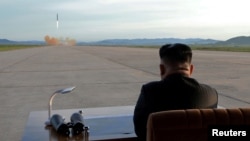North Korea launched an intercontinental ballistic missile Tuesday that traveled about 1,000 kilometers (620 miles), the U.S. Department of Defense confirmed.
The department "detected and tracked a single North Korea missile launch today at about 1:17 p.m. EDT. Initial assessment indicates that this missile was an intercontinental ballistic missile (ICBM)," a statement by Pentagon spokesman Colonel Robert Manning said.
The statement added that the missile "did not pose a threat to North America, our territories or our allies."
The United States was "not surprised" by the development, a U.S. intelligence official told VOA.
The White House press secretary tweeted earlier that President Donald Trump "was briefed, while missile was still in the air, on the situation in North Korea."
In Japan, the Cabinet crisis team was summoned for an emergency meeting. Japan's chief Cabinet secretary said Tokyo "strongly protests" the launch.
"We are very concerned and we have condemned them publicly. We told the North Koreans that we criticize their behavior in the strongest terms possible," Japanese Ambassador to the United Nations Koro Bessho said.
The U.N. Security Council has not yet called an emergency meeting to discuss the missile launch.
“Initial reports indicate [it was] a ballistic missile that landed within Japan's EEZ," or exclusive economic zone, an area in which a coastal nation has jurisdiction over natural resources. "I presume this kills off the nascent theory that Kim Jong Un was non-verbally signaling good faith toward the U.S.A. through a self-imposed testing freeze,” said Dennis Roy, senior fellow at the Hawaii-based East West Center.
Japanese news outlet NHK reported that the missile flew for 50 minutes before landing in Japan's EEZ.
The launch would be North Korea's first since it fired a missile over Japan in mid-September. Some experts had indicated North Korea's Kim would hold his fire until around the Winter Olympics in February.
"I am surprised but not shocked when it comes to this move,” Harry Kazianis of the Center for the National Interest, told VOA on Tuesday. “North Korea, who did test two missiles in the fourth quarter last year, will have to continue to test its missile capabilities for years to come if it wants a nuclear deterrent that can hit the U.S. homeland.”
The latest North Korean launch came as the U.S. and South Korea are preparing a joint exercise called “Vigilant Ace” for December 4-8, with thousands of military personnel and more than 230 aircraft participating, including six F-22 Raptor fighter jets deployed to South Korea for the first time.
Pyongyang routinely condemns such military drills using belligerent language and military threats.
Pentagon correspondent Carla Babb, national security correspondent Jeff Seldin, White House correspondent Steve Herman and Seoul correspondent Daniel Schearf contributed to this report.













